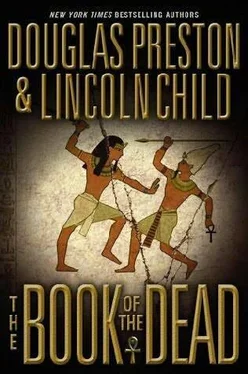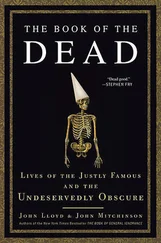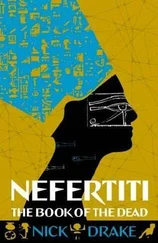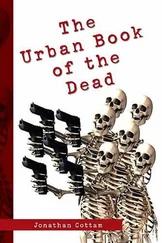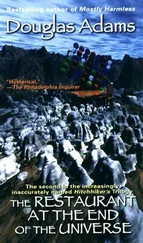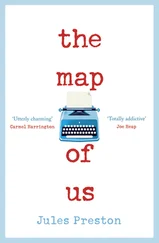Nora glanced around. Initially, she had been against that little piece of drama, but she had to admit that-judging by the excited murmurs and gasps of the audience-it had been effective. Even the mayor’s wife, despite her faint objection, seemed enthralled.
More invisible holographic screens now descended as others rose, and the computer-controlled video projectors seamlessly transferred the images of the robbers from one screen to the next, giving them the illusion of three-dimensional motion. The effect was extraordinarily real. And yet-the moment the last visitor left the tomb-the screens would all retract and the images of death and destruction would be cut off, leaving the hall in its original pristine shape and ready for the next performance.
The guests followed the holographic figures into the Hall of the Chariots. Here, the robbers fanned out, awestruck at the incredible wealth spread out before them-heaped-up gold and silver, lapis, and gemstones, all gleaming dully by torchlight. The audience itself was halted by a lowered barrier at the far end of the hall, and the second section of the show began with another voice-over:
The Tomb of Senef, like many ancient Egyptian tombs, contained an inscription that cursed those who would despoil it. But an even greater deterrent than a curse was the robbers’ own terror of the power of the pharaoh. For these high priests, although greedy and corrupt, were also believers. They believed in the divinity of the pharaoh and in his everlasting life. They believed in the magical properties which had been invested in the objects buried in the tomb with him. The magic in these objects was extremely dangerous and would do the robbers great harm if it were not canceled.
For this reason, the first thing the robbers did was destroy all the grave goods in the tomb, as a way to expunge their magical powers.
The robbers, having recovered from their initial awe, began to pick up objects and hurl them about-tentatively at first, then working up to an orgy of destruction, smashing furniture, vases, armor, and statues, hurling them against the walls, dashing them onto the stone floors, or swinging them into square pillars, sending ghostly projections of gemstones, gold, and fragments of alabaster skittering and rattling everywhere. They screamed and cursed as they worked. Other robbers scrambled about on their hands and knees, sorting through the destruction for things of value and stuffing them into sacks.
Once again, the illusion was remarkable.
Everything would be destroyed. The only things of value taken from the tomb would be taken in pieces and further reduced as soon as possible. Metals would be melted down into bullion; jewels, inlaid lapis, turquoise, and jasper would be pried from their settings and recut. All this treasure would then be quickly exported from Egypt, where any residual power of the godlike pharaoh still residing in the objects would be lost.
That would be the fate of all the beautiful and precious objects in the tomb-total annihilation. The work of thousands of craftsmen over years, reduced in a single day to broken shards.
The frenzy of cursing, screaming, and destruction grew. Nora glanced at the mayor and his wife; both were staring at the scene, mouths open, astonished and utterly captivated. It was the same for the rest of the crowd. Even the police officers and the camera crew looked spellbound. Viola Maskelene caught her eye. The Egyptologist nodded and gave her a thumbs-up.
Nora shivered once again. The Tomb of Senef was going to be a success-a huge success. And-she couldn’t help but think-she was the chief curator of the tomb. This was to her credit. Menzies had been right: this would make her career.
The voice-over resumed:
And now, having destroyed the Hall of the Chariots and gleaned all treasure of value, the robbers moved into the deepest section of the tomb: the so-called House of Gold, the burial chamber itself. This was the richest-and most dangerous-part of the tomb. Because here is where the pharaoh himself rested, his body-it was believed-mummified but not dead.
Still clutching their torches, sweaty and frenzied from their spree of destruction, the holographic figures moved through the far archway and into the burial chamber. The retaining gates opened and the crowd followed them across the Hall of the Chariots and into the burial chamber, gathering behind another barrier that descended from the ceiling. The voice-over continued as the show began to move toward its climax:
The burial chamber was the resting place of the mummified body of the pharaoh, which contained the pharaoh’s Ba-soul, one of the five souls of the dead.
The robbery was planned for broad daylight. That was deliberate: according to Egyptian belief, the pharaoh’s Ba-soul was absent from the tomb during the day, journeying with the sun across the sky. At sunset, the Ba-soul would reunite with the pharaoh’s mummy. Woe to the robber caught in the tomb after dark, when the mummy came back to life!
But these robbers have not been careful. Clocks did not yet exist, and in the darkness of the tomb a sundial was useless. They have no way of keeping track of time. And little do they know that, outside the tomb, the sun is already setting…
Once again, the robbers flung themselves into an orgy of violence, smashing the canopic jars, scattering Senef’s mummified organs, breaking open baskets of grains and breads, tossing about mummified foodstuffs and pets, decapitating statues. Then they set to work on the great stone sarcophagus itself, jamming cedar poles under one side, slowly dislodging the one-ton lid and wedging it back, millimeter by millimeter, until it toppled from the sarcophagus and broke in two on the floor. Through the magic of holographic projection, the effect was again remarkably real.
Nora felt somebody touch her elbow, and she glanced down to see the mayor smiling at her. “This is utterly fantastic,” he whispered with a wink. “It looks like the curse of Senef has finally been lifted.”
Looking at his bald pate and round, shiny face, Nora had to smile to herself. He was eating it up, just like an overgrown kid. They all were.
There was no longer any doubt in her mind: the show was a huge-a monster-success.
D’Agosta watched in sick disbelief as the technicians, both of them now working frantically, continued to type commands on their keyboards.
“What’s wrong?” Hayward demanded.
Enderby wiped his forehead nervously. “I don’t know. The terminal isn’t accepting my commands.”
“Manual override?” Hayward asked.
“Tried that already.”
Hayward turned to Manetti. “Notify the guards in the tomb. Tell them we’re shutting down the show.” She pulled out her radio, preparing to talk to her own officers on the inside. Then she paused, staring at Manetti, who had gone pale. “What is it?”
“That’s just it. I’m trying to contact my men in the tomb. There’s no communication. None.”
“How can that be? They’re less than fifty yards away!”
“The tomb has been shielded against radio frequencies,” said Pendergast quietly.
Hayward put down her radio. “Use the P.A. system. It’s hardwired, right?”
More furious typing from Enderby. “That’s down, too.”
Hayward stared at him. “Cut power to the doors. In the event of a total power failure, they can be levered open by hand.”
Enderby typed some more, then raised his hands in a gesture of futility.
Suddenly, Pendergast pointed at one of the monitors displaying a live feed of the hall. “Did you see that? Rewind it, please.”
One of the technicians digitally rewound the image.
“There.” And Pendergast indicated the blurry outline of a figure, off to one side in the shadows.
Читать дальше
